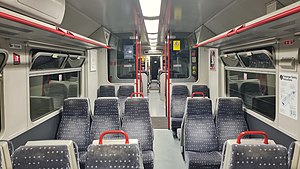| British Rail Class 321 | |
|---|---|
 Greater Anglia Class 321 at Colchester in 2018 | |
 Standard-class interior of an unrefurbished Greater Anglia unit | |
| In service | 1988–present[1] |
| Manufacturer | British Rail Engineering Limited |
| Built at | Holgate Road Works, York |
| Family name | BR Second Generation (Mark 3) |
| Replaced | Class 307 |
| Constructed | 1988–1991 |
| Refurbished | 2013–2017 |
| Number built | 117 (66 × 321/3, 48 × 321/4, and 4 × 321/9)[2] |
| Number in service | 8 (plus 12 converted to Cl. 320/4) |
| Number scrapped | 67 |
| Successor | |
| Formation |
|
| Diagram | (See § Vehicle numbering) |
| Fleet numbers |
|
| Capacity |
|
| Owners |
|
| Operators | |
| Specifications | |
| Car body construction | Steel |
| Train length | 80.92 m (265 ft 6 in)[1] |
| Car length |
|
| Width | 2.816 m (9 ft 2.9 in) |
| Height | 3.775 m (12 ft 4.6 in) |
| Doors | Double-leaf sliding pocket, each 1.200 m (3 ft 11.2 in) wide (2 per side per car) |
| Wheelbase | Over bogie centres: 14.170 m (46 ft 5.9 in) |
| Maximum speed | 100 mph (161 km/h) |
| Weight |
|
| Traction motors | |
| Power output |
|
| Acceleration | |
| Electric system(s) | 25 kV 50 Hz AC overhead |
| Current collector(s) | Pantograph |
| UIC classification | 2′2′+Bo′Bo′+2′2′+2′2′ |
| Bogies |
|
| Minimum turning radius | 71 m (232 ft 11 in) |
| Braking system(s) | Electro-pneumatic (disc) |
| Safety system(s) | |
| Coupling system | Tightlock |
| Multiple working | With Classes 317–322 |
| Track gauge | 1,435 mm (4 ft 8+1⁄2 in) standard gauge |
| Notes/references | |
| Specifications as at October 1988[7] except where otherwise noted. | |
The British Rail Class 321 is a class of electric multiple unit (EMU) passenger train built by British Rail Engineering Limited's York Carriage Works in three batches between 1988 and 1991 for Network SouthEast and Regional Railways. The class uses alternating current (AC) overhead electrification. The design was successful and led to the development of the similar Class 320 and Class 322.
After operating for various trains operating companies after the privatisation of British Rail, they were latterly operated by Greater Anglia until April 2023. Some have been converted to Class 320 and are operated by ScotRail.
- ^ a b c d "Class 321 Electrical Multiple Unit" (PDF). Eversholt Rail. Archived from the original (PDF) on 5 October 2015.
- ^ Inman, Mark Lee; Pritchard, Robert. "Endangered species: the Class 321s". Today's Railways UK. No. 250 (December 2022). Sheffield: Platform 5. p. 52. ISSN 1475-9713.
- ^ Cite error: The named reference
TRM1475was invoked but never defined (see the help page). - ^ Marsden, C. J. (2007). "Class 321". Traction Recognition. Hersham: Ian Allan Publishing. pp. 178–181. ISBN 978-0-7110-3277-4. OCLC 230804946. OL 16902750M.
- ^ "Class 321 EMU overhaul for Eversholt". Wiener Neudorf: Traktionssysteme Austria. Retrieved 28 January 2023.
- ^ "Class 321 Renatus". London: Eversholt Rail Group. Archived from the original on 9 January 2021. Retrieved 5 August 2021.
- ^ "Vehicle Diagram Book No. 210 for Electric Multiple Units (including A.P.T.)" (PDF). Derby: Mechanical & Electrical Engineering Department, British Railways Board. EC210, EE236, EE308, EH235 (in work pp. 88–89, 182–183, 206–207, 316–317). Archived from the original (PDF) on 21 January 2015. Retrieved 8 October 2022 – via Barrowmore MRG.